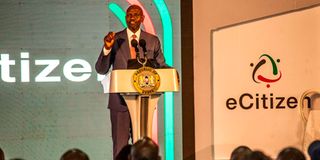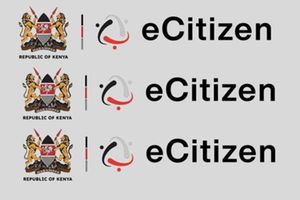
President William Ruto delivers his speech during first anniversary celebrations of Hustler Fund in Nairobi.
They say when you want to kill a dog, you first give it a bad name. And a bad name is what the Kenya Kwanza administration gave the National Integrated Identity Management System (NIIMS), popularly known as Huduma Namba, before pulling the plug on one of retired President Uhuru Kenyatta’s projects.
“That Huduma Namba was a complete fraud because we lost almost Sh15 billion and got very little out of it,” President William Ruto said in June 2023, while announcing that his government would unveil a better, cheaper version in three months.
His government would put the cost of Huduma’s replacement, Maisha Namba, at not more than Sh1 billion.
This recycling of systems is not restricted to NIIMS. Since coming to power in September 2022, the Kenya Kwanza administration has launched at least 17 portals with a conservative total of Sh147.5 billion so far, an analysis of official data by the Sunday Nation shows.
Maisha Namba alone would cost Sh12 billion, not Sh1 billion as the President had said.
Implementation of the so-called Maisha ecosystem will see the State spend another Sh31 billion for the supply of the Maisha card and Maisha digital card, Treasury data shows.
Previously, the estimated cost of this portal was Sh5 billion.
Despite registering around 38 million Kenyans, the Huduma Namba project faced a myriad of challenges, from low card collection rates to legal disputes on issues such as data privacy concerns. Dr Ruto’s administration would later discontinue Huduma Namba in favour of Maisha Namba, a new digital ID initiative.
Now, it appears the rollout of the new digital IDs – Maisha Namba, the Maisha Card (a third-generation ID), the Digital ID, and the National Master Population Register – will cost taxpayers nearly three times what Kenyans had paid for Huduma Namba.
A big chunk of the cash that will go into new systems is the Social Health Insurance Fund (SHIF), which replaced the National Hospital Insurance Fund (NHIF). The new system is undergirded by a platform that is reported to have an estimated cost of Sh104 billion.
The government awarded the development of an Integrated Healthcare Information Technology System (IHTS) to a consortium led by telecommunications provider Safaricom, along with foreign partners.

President William Ruto during the launch of e-Citizen services, GavaMkononi app and Gava Express at KICC in Nairobi on June 30, 2023.
However, because this procurement was conducted through a single-sourcing process, bypassing competitive bidding, questions were raised about transparency and compliance with public procurement laws.
There were also concerns on whether it was necessary to build a new expensive system from scratch rather than fixing the loopholes in NHIF.
The recent decision by the Treasury to develop an electronic government procurement system (e-GP) has also sparked an uproar by lawmakers who reckon it is a waste of funds. The project, which was initially started by the Jubilee administration, was part of Kenya’s commitment to the International Monetary Fund.
The new e-procurement system will replace parts of the existing Integrated Financial Management Information System (Ifmis), which already incurs an annual maintenance cost of Sh1.2 billion, with MPs questioning the necessity and timing of this huge expenditure.
Treasury insists that the system will save taxpayers’ funds by, among other things, linking it to banks and Kenya Revenue Authority (KRA), with the latter able to directly obtain data on financial activity and tax compliance records for those seeking to do business with State entities.
Treasury Principal Secretary Chris Kiptoo told the National Assembly that the link will enable tender evaluation committees in ministries, departments, and agencies as well as counties, to have visibility of inflows and outflows.
Other major system launches
The National Education Management System (Nemis) has also been turned into the Kenya Education Information System (Kemis).
This web-based platform developed by the Ministry of Education to collect, manage, and analyze data across the country, was funded by an $88.4 million (Sh11.42 billion) grant from the Global Partnership for Education.
In the financial year ending June 2022, Nemis was allocated an additional Sh239.78 million to reengineer and upgrade the platform. However, the system would later be plagued by limitations in aligning with the new Competency-Based Curriculum (CBC).
That is why the Ruto-led administration replaced Nemis with a more comprehensive system, Kemis, which is estimated to have cost Kenyans close to Sh572 million.
The Kenya Kwanza administration has also developed the Integrated County Revenue Management System (ICRMS), a digital platform to streamline and automate revenue collection for county governments, at an estimated cost of Sh3.75 billion.
The other major system launched by the Ruto-led administration is the Integrated Export and Import Certification System, a digital platform developed by the Kenya Plant Health Inspectorate Service in June last year to streamline certification processes for the import and export of plant materials. Its estimated cost is Sh19.8 billion, according to Treasury data.
Treasury has also upgraded the Pensions Management Information System at a cost of Sh1.88 billion to weed out ghost retirees.
Other major system launches or upgrades include the Public Land Information Management System (Sh352 million), Open Space Office Modelling and Security System (Sh200 million), and the Integrated Resilience for Sustainable Food Systems (Sh294 million).









